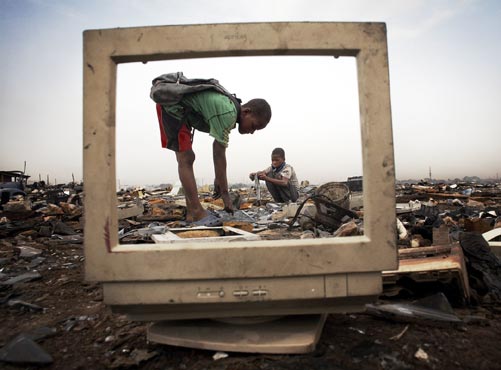Centre acts tough on e-waste

India is witnessing phenomenal growth in e-waste generation, ranked third globally, compelling the Central government to revise e-waste management rules 2016 under which improper management of such refuse leading to environment damage will invite financial penalty. Over 17 lakh tonnes of such waste is generated and it is growing at a five per cent rate annually and is expected to grow further. Also, dismantling of e-waste is largely done in an unorganised way in the country.
CFL and other mercury lamps have been brought within the ambit of the e-waste management rules 2016, and a ‘Deposit Refund Scheme’ has been introduced under which the producer of any computer, mobile phone or other electronic product will have to persuade consumers to return the products after usage for a small sum. These rules are in supersession of the e-waste (Management and Handling) Rules of 2011.
The producers will be brought under Extended Producer Responsibility (EPR) and made responsible for collection of e-waste and its exchange. The bulk consumers must collect the items and hand them over to authorised recyclers. Various producers can have a separate Producer Responsibility Organisation (PRO) and ensure collection of e-waste as well as its disposal in an environmentally sound manner. There is a liability clause with financial penalties, where environmental degradation is happening and things are not being done scientifically.
E-waste, which comprises precious metals like gold and silver, can produce more gold than what is obtained through mining. It is observed that people are after these precious metals while handling e-waste. They take it out of the product and burn it which is why toxic gases are generated. They then throw the waste in water or to leeches. Also, the workers who are involved in this task suffer from neurological disorders, skin diseases and cancer.
Less than 2 per cent of India's total e-waste gets recycled due to absence of proper infrastructure, legislation and framework. As per estimates, 100 crore mobiles are used every year in the country, out of which 25 crore become e-waste.
Televisions, refrigerators and washing machines contribute to majority of e-waste, while computers account for another 20 per cent and mobile phones over 2 per cent.
The domestic e-waste contains over 1,000 toxic materials, which contaminate soil and ground water. Their exposure can cause headache, irritability, nausea, vomiting and eye pain.
Recyclers have a risk of developing liver, kidney and neurological disorders. Not only that, their components can contain toxic substances such as lead, cadmium, mercury, hexavalent chromium, plastic, barium, beryllium, and carcinogens like carbon black and heavy metals. Printed circuit boards contain heavy metals like antimony, gold, silver, chromium, zinc, lead, tin and copper.
A United Nations report projects that by 2020, e-waste from computers would increase by 500 per cent and discarded mobile phones will increase 18 times from 2007 levels in India. Informal workers currently collect, dispose and recycle majority of e-waste. India has about 4.5 lakh child labours between the age group of 10-14 engaged in variouse-waste activities, without adequate protection and safeguards in various yards and recycling workshops.
D S Rawat, secretary general, Assocham, says, “e-waste is directly linked to the economic growth of the country and also overall consumer spending pattern. India’s economic growth has lifted millions of people from lower-income group to middle and high-income groups and increased purchasing power.”
Rawat points out, “Issues relating to poor sensitisation about this sector, low organised recycling, cross-border flow of waste equipment into India, limited reach out and awareness regarding disposal, after determining end of useful life, and lack of coordination between various authorities responsible for e-waste management and disposal including the non-involvement of municipalities in e-waste management.”
Hyderabad, one of the fastest growing IT hubs in India, is also witnessing a challenge. The pile of e-waste, the city is generating year-after-year surely calls for a careful management. According to a report released by the National Association of Software and Services Companies during end of 2015, IT companies in the city are generating 4,000 of metric tonnes of e-waste annually. While 39 per cent of the companies store their e-waste for a period of one year, 15 per cent of the companies dispose them off within six months.
-
Related News
-
More from Metro India

